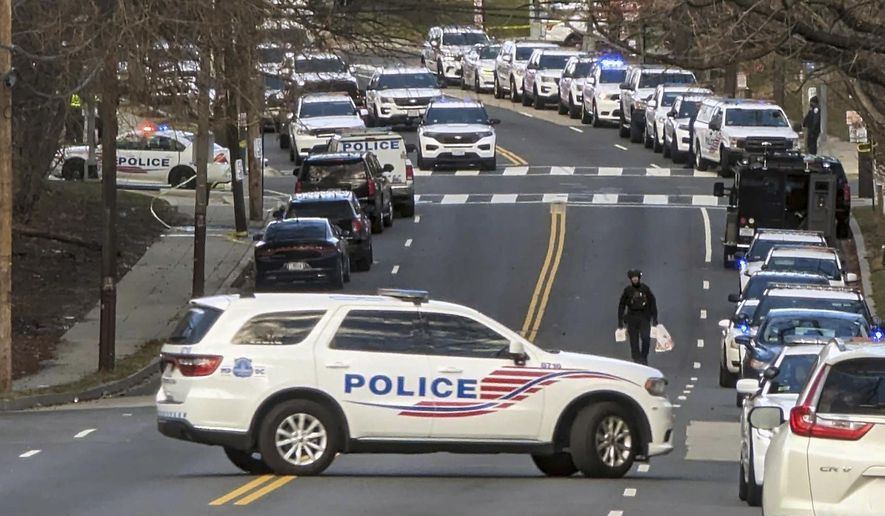D.C. residents say they are still wary after rampant and often brazen violence plagued the city last year despite assurances from local officials and police authorities that crime in every major category is down this year.
Mayor Muriel Bowser and leaders in the Metropolitan Police Department have touted the 24% drop in violent crime during public events through the first four months of 2024.
Homicides are down 28%, carjackings are down 31% and muggings are down 22%, putting the District on track with a nationwide trend of lower crime rates in big cities.
Last year, the city recorded a 26-year-high in homicides, a record-high number of violent car thefts and frequent ambush-style robberies in side streets and commercial corridors.
The statistics aren’t resonating with locals. The rampant violence shook some residents to the point that they looked into hiring private security for their neighborhoods.
“They were going to be patrolling all of our streets,” Ann Garlow, a resident of 16th Street Heights in Northwest, told The Washington Times. “It was a crime deterrent we were after.”
Ms. Garlow said she and about 30 of her neighbors planned to have the security firm keeping watch over a seven-block area after an increase in armed robberies, violent car thefts and a homicide.
Negotiations with the security company collapsed. Ms. Garlow said the idea for paid security generated interest after the MPD said it couldn’t send more patrols to the neighborhood.
Parts of the District that have long struggled with crime are scarred from a turbulent 2023.
“Personally, I think it’s still the same,” Curtis Brothers, who lives in the Greenway neighborhood in Southeast and runs the organization Saving Our Youth, told The Times. “As you can see, the carjackings are still up … and I think we’re about to get another spike [in crime] because the weather’s getting too good and people are starting to go outside more.”
Despite the recorded drop in crime, the city has been peppered with jarring episodes of violence.
In January, police said a man gunned down two people and carjacked multiple vehicles before he was killed in a shootout with police in Prince George’s County, Maryland.
One of two barricade situations in February erupted because a gunman shot three MPD officers.
A 14-year-old boy was fatally shot at the Brookland Metro Station this month. Days later, police said, at least two people sprayed down a neighborhood block in Northeast. One man was killed, and five others, including two boys, were wounded.
Such incidents are becoming less common, according to city statistics.
U.S. Attorney Matthew Graves, the federal prosecutor who handles most serious crimes in the city, said at a recent community crime meeting at MPD’s 4th District station that shootings are down 30% this year.
D.C. Administrator Kevin Donahue said this winter that a higher rate of gunshot victims were mortally wounded last year.
A quarter of all people who were shot last year died from their injuries, Mr. Donahue said, compared with roughly 18% in 2017. He said that increase accounted for more than 50 homicides last year.
Mr. Graves, who has been badgered for his office’s woeful prosecution rate, appeared correct to say the District was six to 12 months behind the rest of the country in getting control of its pandemic lockdown crime wave.
Data showing less violence on the streets isn’t persuading anyone to celebrate.
“Sure, crime is down from its zenith last year, but we’re still well above where we were a decade ago,” said one downtown resident, who asked not to be identified.
The resident encouraged people to chat with Uber Black drivers, the ride-hailing service’s luxury option. He said drivers are terrified of coming into the city and having their expensive vehicles stolen at gunpoint.
How to keep crime rates down is up for debate.
Ms. Garlow from 16th Street Heights said the city would benefit from providing a basic income for all residents. She said it would prevent people from feeling that they need to commit crimes to support themselves.
Others say the best way to improve safety in the District is to rebuild interpersonal bonds that once kept communities together.
“We’ve got to put the ‘neighbor’ back inside ‘neighborhood’ and put the ‘unity’ back inside ‘community,’” said Prince Hamn, who works with at-risk youths in Southeast with his organization Making A Difference. “We’ve got to start knowing one another before we start doing some of these violent crimes.”
Mr. Hamn said a lack of connection makes criminals more prone to victimize their neighbors.
Mr. Hamn also suggested that city leaders focus more on violence prevention and interruption efforts, given that crime in the District is becoming more manageable. He said outreach at schools, neighborhood events and even the D.C. Jail would prevent violence from spiking again.
His suggestion also relies on people to take the message seriously. Mr. Hamn said those who lack the discipline to stay away from a life of crime will soon find themselves “inside the gravesite, as sad as that is to say.”
• Matt Delaney can be reached at mdelaney@washingtontimes.com.




Please read our comment policy before commenting.